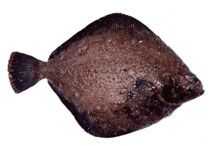Roughscale Sole

Species Details
Clidoderma Asperrimum
Pleuronectidae
Pleuronectiformes
Open Water, Rocky Reefs, Coral Reefs, Wrecks
1 - 6 lbs.
8" - 24"
Roughscale Sole (Clidoderma asperrimum) Description
The Roughscale Sole is a member of Pleuronectidae which is characterized by their eyes being on their right side. Like any flatfish or sole, the Roughscale Sole usually swims by propelling itself by using its large ventral and dorsal fins. The Roughscale Sole gets its name from the beads that seem to protrude from its body, giving it a rough texture. Color-wise, they appear to be a pale brown-red color. The dorsal and ventral fins of the Roughscale Sole appear to be light red to pale orange. Its tailfin looks similar to that of a paintbrush.
From the top, the Roughscale Sole’s skin can look similar to a pebble stone flooring near a swimming pool. Although they’re not sharp, it’s still quite bumpy to walk on. Roughscale Soles also have small light red pectoral fins that help them make sharp turns as they propel themselves through the water.
Diet and Size
Roughscale Soles, according to a study, appear to like eating Brittle Stars. They also have a liking towards Amphipods such as freshwater shrimps, scuds, and side swimmers. Roughscale Soles are known to dig through the sand to find their food, making it also possible that they do like some other smaller crustaceans from the Gammaridea suborder of Ampiphodas.
A Roughscale Sole can range between 8 to 24 inches in length. However, there appears to be a difference between a male Roughscale Sole and a female Roughscale sole. Male Roughscale Soles although they grow faster stop at only 21 inches where the females were the ones that reached 24 inches in length. Their usual length however between both sexes was 15 inches.
Interesting Facts about the Roughscale Sole
- Female Roughscale Soles lived longer than males.
- Although not sure, the possible lifespan of Roughscale Sole is 18-20 years.
- Roughscale Soles are considered rare in the West but are actually quite common in the East.
- In Japan, Roughscale Soles are prized at 3,000 to 8,000 JPY.
- Roughscale Soles are known for their fat, white, tasty flesh.
- The ratio of the usual school of Roughscale Sole appears to be 2:1.
Fishing Techniques: How to catch a Roughscale Sole
One of the most common ways used to catch Roughscale Sole is via trawling. However, some people can try also catching a Roughscale Sole the same way they do catching all kinds of sole: Deep Fishing. Like any kind of sole, Roughscale Soles usually stay burrowed in the ground where people can’t find them. They try to blend with the rocky and coral reefs to avoid any possible predators.
Most people don’t really target a Roughscale Sole but you can do it by switching up the bait. They appear to have a preference for shrimp so you can use that as your main bait. If you can find Brittle Stars, that’s one of their preferred foods too. As to whether they’re alive or not, a Roughscale Sole would most likely prefer to have it alive than dead. Similar to their other sole cousins (English sole, the Dover Sole, and etc.), they will look for that slight wriggle to see if it’s worth eating. They appear to like ambushing also like some of their cousins, giving you a better chance of catching them using live bait.
For lures, a jig would be preferred. Jigs sink faster and are easier to monitor when going deep fishing. For hook size, a size 2-4 will do since these fish also have small mouths. As for the tackle weight, medium to heavy tackle will be good. Having a braided tackle will also prevent your line from snapping due to the pressure of the water and the sudden run of a Roughscale Sole.
Habitat and Distribution
Roughscale Soles are not commonly found in Western waters. They are commonly found in the Pacific Ocean. Usually, they appear in the North Pacific which makes them a common food fish for those in China and Japan. However, there are times that Roughscale Soles can also appear in California after they migrate from Japan to head west. They appear to be more common among the Kuril Islands and Kamatchka waters.
As deep-water fish, Roughscale Soles will have a preference for rocky bottoms and coral reefs. They would look for places that are abundant in shrimp or in Brittle Stars. They’ll most likely slip into crevices as well where they can dig into the sand and hide from possible predators.







